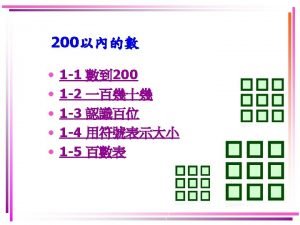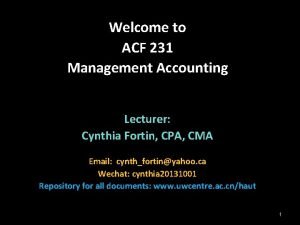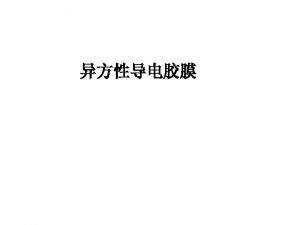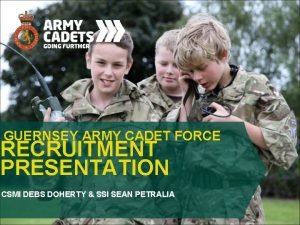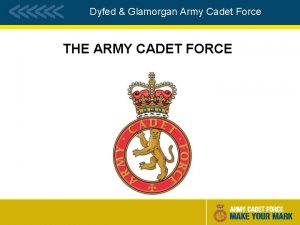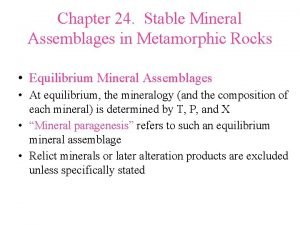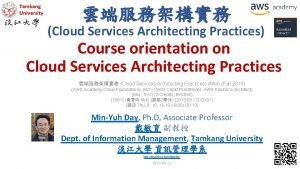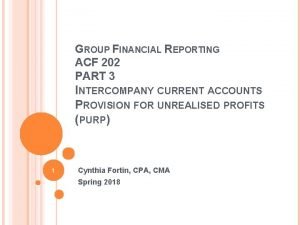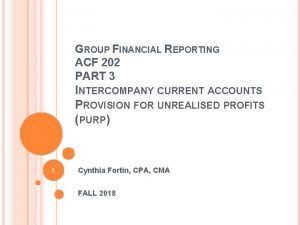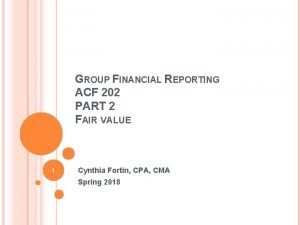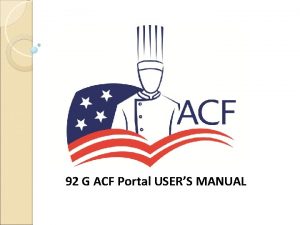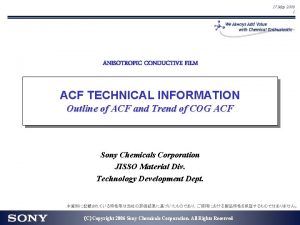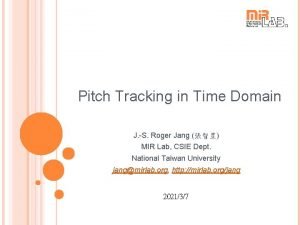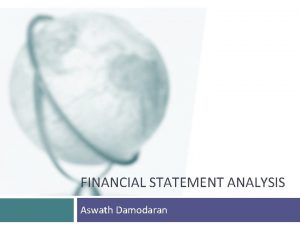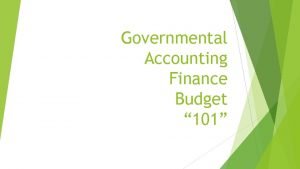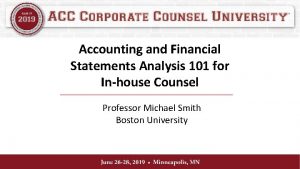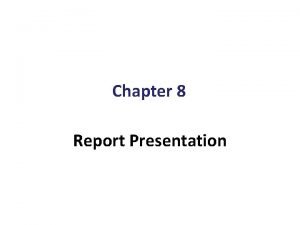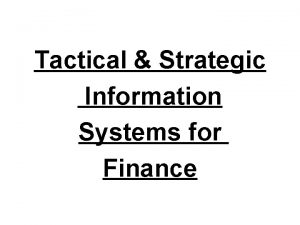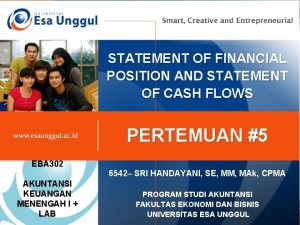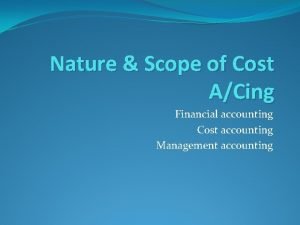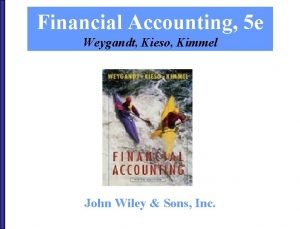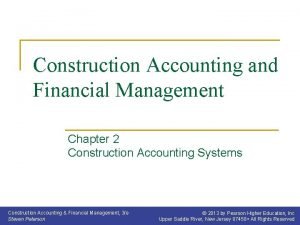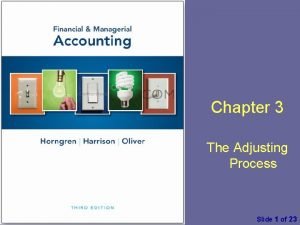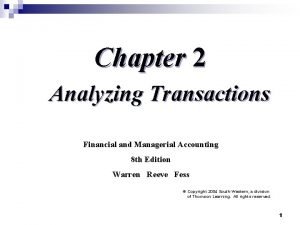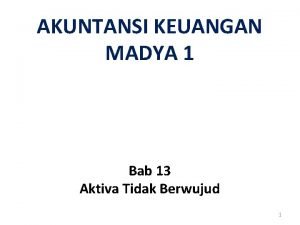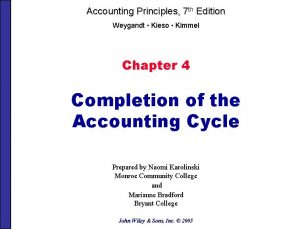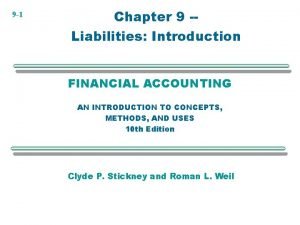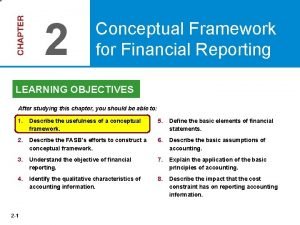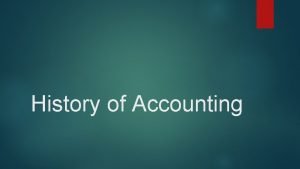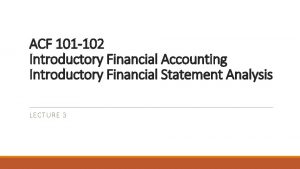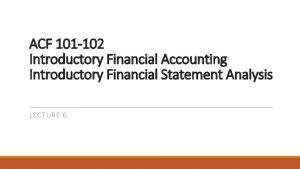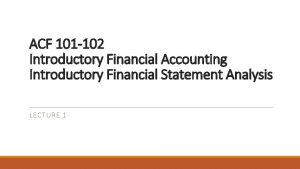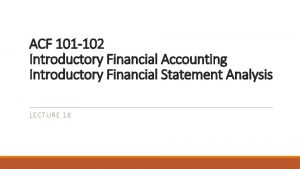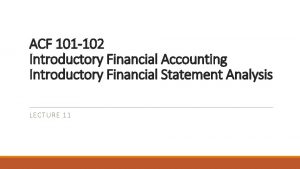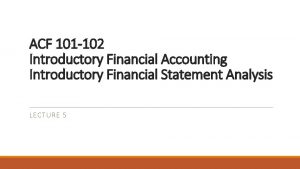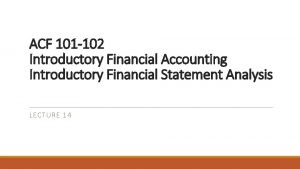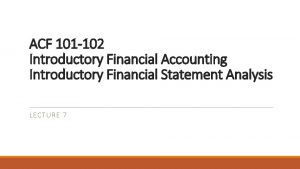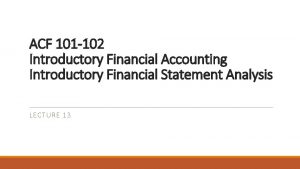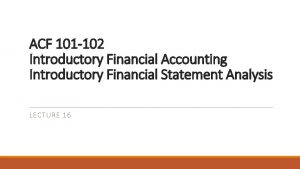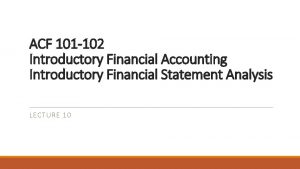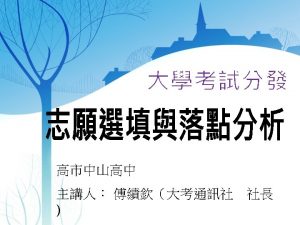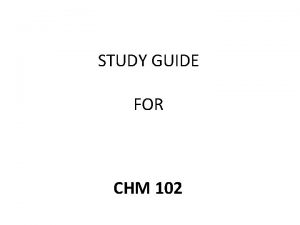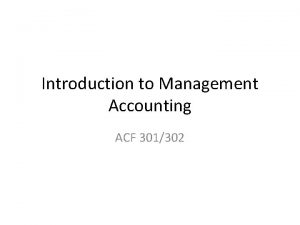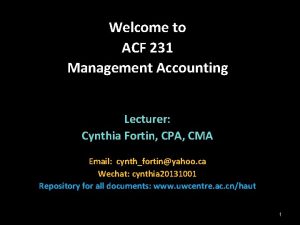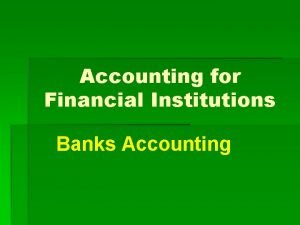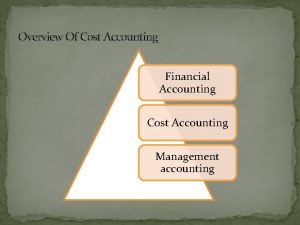ACF 101 102 Introductory Financial Accounting Introductory Financial







































- Slides: 39

ACF 101 -102 Introductory Financial Accounting Introductory Financial Statement Analysis LECTURE 12

Learning Outcome Understand the accounting concepts and conventions present in accepted accounting principles and their application in financial statements analysis. Demonstrate knowledge and understanding of the various methods of providing for depreciation

Topics Long-lived Assets Tangible Assets Depreciation Sales of Assets

Overview of Long-lived Assets Long-lived assets (LLA) ◦ Used over a period longer than an operating cycle ◦ As a percentage of total assets, vary considerably depending on the industry ◦ Divisible into tangible and intangible categories Tangible assets - physical (can see and touch) ◦ Land ◦ Natural resources ◦ Buildings ◦ Equipment

Overview of Long-lived Assets Intangible assets – Lack physical substance ◦ Contractual or legal rights or economic benefits ◦ Patents ◦ Trademarks ◦ Copyrights Amortize – spreading the LLA’s cost over the periods it contributes to the production of revenue ◦ Depreciate – buildings, equipment (but not land) ◦ Deplete – natural resources ◦ Amortize – intangible assets

Contrasting Long-lived Asset Expenditures with Expenses Expenditures – what is paid for an item “Expensed” – Within an operating cycle or year ◦ Not consumed - current asset ◦ Consumed - deducted as an expense (“expensed”) “Capitalize” – Beyond an operating cycle or year, expenditure is placed on the balance sheet (capitalized) ◦ Cost is then amortized over its useful life ◦ Exceptions – Land other items where cost-benefit considerations suggest expensing is justified

Contrasting Long-lived Asset Expenditures with Expenses Capitalize or Expense? – judgment required ◦ Expensing all this year lowers this year’s net income (and has no affect on future years net income) ◦ Capitalizing this year then amortizing some of its cost lowers this years expenses (in comparison to expensing) thus improving this year’s net income. In future years, more expenses means lower net income ◦ In the long-run, same end results are achieved ◦ What is in the best interests of stakeholders (management, investors) World. Com example in text – What did they do?

Tangible Assets Acquisition Cost LLA asset costs that are capitalized include (besides the purchase price itself – $100 ) all necessary costs to get the asset into a usable condition ◦ Land – survey, legal/title fees, taxes, demolition ◦ Buildings – legal/title fees, taxes ◦ Equipment - taxes ($5), transportation ($3), installation ($4), testing ($1), essential repairs ($2) to get it into an operating condition ASSET CASH 115

Tangible Assets Acquisition Cost Nonmonetary exchange – Fair market value ◦ Fair market value = what could sell/buy the asses for from an independent third party ◦ Fair market value of the consideration given up or received, whichever is more clearly determinable Basket Purchase – more than one asset for a single price. E. g. For $1 M, can buy Land ($480, 000) and building ($720, 000) (appraised value) Building Land Cash 600, 000 (720/1200) x $1 m) 400, 000 (480/1200 x $1 m) 1, 000

Tangible Assets Acquisition Cost Subsequent to Acquisition - The market value: ◦ Declines ◦ Write the value of the asset down (impairment if considered permanent), or ◦ Leave at historical cost less depreciation, i. e. , Book Value ◦ U. S. required and IFRS permitted ◦ Increases ◦ Revalue to fair market value (IFRS permitted) ◦ Precluded by U. S. GAAP

Building/Equipment Depreciation Matching – recording expenses in the period in which they help produce revenue Buildings and Equipment ◦ Typically last many years ◦ Thus contributing to revenue for many years ◦ Thus their cost is capitalized when purchased ◦ And amortized over many years Accumulated Depreciation = the cumulative amount of Depreciation Expense recorded over the life of the asset

Building/Equipment Depreciation Information needed to determine depreciation ◦ Acquisition (capitalized) cost – what was debited to the asset account ◦ Salvage (terminal, residual) value – what is expected to be received at the time the asset is disposed of ◦ Depreciable value = amount to be allocated to each year of usage ◦ Useful life = shorter of the asset’s ◦ Physical life – expected time it will wear out ◦ Economic life – when it is no longer economically feasible to operate

Building/Equipment Depreciation Symbols Amounts for Illustration C = total acquisition cost December 31, 20 X 2 $41, 000 R = estimated residual value $1, 000 n = estimated useful life (in years or miles) 4 years 200, 000 miles D = amount of depreciation Various

Building/Equipment Depreciation Straight-line depreciation ◦ Spreads the depreciable value evenly over the useful life of an asset ◦ Most popular method for financial reporting purposes Depreciation expense = (C – R) / n = ($41, 000 – 1, 000) / 4 = $10, 000 per year Depreciation Expense Accumulated Depreciation 10, 000

Building/Equipment Depreciation Units of Production - If physical wear and tear determines the useful life, depreciation may be based on units of service (e. g. miles) or units of production Depreciation expense = (C – R) / n = ($41, 000 – 1, 000) / 200, 000 = $. 20/mile = 65, 000 miles (yr 1) x $. 20 = $13, 000 Depreciation Expense 13, 000 Accumulated Depreciation 13, 000

Building/Equipment Depreciation Double-declining-balance (DDB) method is an accelerated method Straight line rate of depreciation = ¼ year = 25% per year Double the straight line rate = 25% x 2 = 50% Book value at the begin. of the year = Acquisition cost less – Accumulated Depreciation Year Depreciation Expense 1. 50 ($41, 000 – zero Accum. Depr. ) = $20, 500 > $10, 000 2. 50 ($41, 000 – $20, 500) = $10, 250 3. 50 ($41, 000 – $20, 500 – $10, 250) = $5, 125 4. 50 ($41, 000 – $20, 500 – $10, 250 – $5, 125) = $2, 563 < $10, 000 ◦ $38, 438

Sales of Tangible Assets Example ◦ Original cost - $41, 000 ◦ Accumulated Depreciation at time of sale $20, 000 ◦ Book Value at time of Sale - $21, 000 Sale at book value (all are Asset accounts) Cash 21, 000 Accumulated Depreciation 20, 000 Equipment 41, 000

Sales of Tangible Assets Sale for more than its book value (41, 000 – 20, 000 = 21, 000) Cash 25, 000 Accumulated Depreciation 20, 000 Equipment 41, 000 Gain 4, 000 Sale for less than its book value (41, 000 – 20, 000 = 21, 000) Cash Accumulated Depreciation Loss Equipment 14, 000 20, 000 7, 000 41, 000

Sales of Tangible Assets Companies include gains and losses in a variety of locations on the income statement ◦ Some companies list “other income” with sales revenue at the top of the income statement, thus combining “usual and frequent” inflows with “unusual and/or infrequent” inflows ◦ Other companies report it after operating income—viewing it as not being a part of “usual and frequent” (central) operations

Intangible Assets Intangible assets ◦ ◦ Not physical in nature Rights or claims to expected benefits that are often from contract rights ◦ Patents - exclusive right to produce/sell a product or use a process for up to 20 years ◦ Copyrights – exclusive rights to reproduce and sell a book, musical composition, film, or similar creative item for the life of the creator plus 70 years Accounting for intangible assets depends on whether the asset ◦ ◦ Was acquired externally or developed internally Has a finite or infinite life

Intangible Assets ◦ Trademarks - distinctive identifications of a manufactured product or a service, taking the form of a name, sign, slogan, logo, or emblem ◦ Franchises/licenses - legal contracts that grant the buyer the right to sell a product or service in accordance with specified conditions ◦ Leasehold - right to use a fixed asset for a specified period of time beyond one year ◦ Leasehold improvements - lessee spends money to improve leased property ◦ Improvements = become part of the leased property and are classified as fixed assets

Goodwill ◦ Arises only when one company buys another ◦ Is the excess of the cost of the acquired company over the sum of the fair market value of its identifiable individual assets less the liabilities ◦ Is not separately identifiable intangible asset that could be sold to another company as with other intangible assets

Goodwill Book Value = Assets less liabilities. Recall many things are not shown as assets ◦ Research and Development (R&D) ◦ Intangible assets developed in house ◦ Market value of long-term assets ◦ Nonmeasurable items/events such as reputation, quality of the work force Fair market value (FMV) = the value the market places on the assets, liabilities and all other controlled but not reported items at the time of measurement

Goodwill is the excess of the cost of an acquired company over the sum of the FMV of its identifiable assets less the liabilities ◦ All acquired assets and liabilities are shown at their FMV when the acquisition is recorded ◦ Other items acquired (patents, etc. ) that were not on the seller’s balance sheet are shown at their FMV ◦ If the amount paid for the company exceeds the FMV of the net assets acquired, Goodwill is recorded as an asset by the acquiring company

Long-lived assets are resources that are held for an extended time, such as land, building, equipment, natural resources, and patents that help produce revenues over many periods

Tangible assets are physical items that can be seen and touched (e. g. , land, natural resources —DEPLETION, buildings, and equipment— DEPRECIATION).

Intangible assets— AMORTIZATION are not physical in nature, but are usually rights or economic benefits (e. g. , patents, trademarks, and copyrights).

Distinguish a company’s expenses from expenditures that it should capitalize.

All purchases of goods or services, whether for cash or on credit, are expenditures. Companies capitalize expenditures for assets that benefit more than the current accounting year (i. e. , they add the purchase price to an asset account rather than expensing it immediately).

Capital expenditures add new assets or increase the capacity, efficiency, or useful life of an existing asset. They become expenses in the future, when the company uses the assets. In contrast, expenditures that provide a benefit lasting 1 year or less become expenses in the current year.

Measure the acquisition cost of tangible assets such as land, buildings, and equipment. Land Building and equipment

The acquisition cost of land includes charges to the purchaser for the cost of land surveys, legal fees, realtor's commissions, transfer taxes, and even demolition costs and any cost needed to get the land ready for its intended use.

Land such as plant sites or building sites is ordinarily accounted for separately from other tangible assets.

Under historical-cost accounting, land is carried indefinitely at its original cost, which can be significantly different from its net realizable value.

The services provided by buildings and equipment are consumed. Depreciation recognizes the consumption of these services.

The cost of buildings, plant, and equipment should include all costs of acquisition and preparation for use. Fair value of an asset is the price for which a company could sell the asset to an independent third party.

Companies usually pay for capital expenditures with cash or monetary assets (assets that are fixed in terms of the units of currency). A company may also elect to pay for fixed assets with nonmonetary assets (items whose price in terms of units of currency could change over time). A nonmonetary exchange is generally recorded at the fair value of the asset surrendered.

Some assets (inventory, prepaid rent, equipment) may be considered as stored costs that are carried to future periods rather than charged immediately against revenue.

Assets are unexpired costs held back from expense and carried in the balance sheet in future periods (e. g. , depreciation of buildings, equipment, furniture, etc. ). Depreciation is the systematic allocation of the acquisition cost of long-lived or fixed assets of particular periods that benefit from the use of the assets
 100 101 102 103 104 105 106 107 108 109 110
100 101 102 103 104 105 106 107 108 109 110 Prime numbers up to 200
Prime numbers up to 200 Intermediate accounting chapter 1
Intermediate accounting chapter 1 Social and environmental accounting ppt
Social and environmental accounting ppt Acf 231
Acf 231 Acf electronics
Acf electronics Army cadet force values and standards
Army cadet force values and standards American culinary federation certification
American culinary federation certification Army cadet force syllabus
Army cadet force syllabus Chemographic diagrams for metamorphic rocks
Chemographic diagrams for metamorphic rocks Aws academy cloud foundations (acf)
Aws academy cloud foundations (acf) Purp accounting
Purp accounting Purp in accounting
Purp in accounting Acf 202
Acf 202 Acf portal
Acf portal Acf ncf
Acf ncf Acf formula
Acf formula Which items are miscategorized balance sheet
Which items are miscategorized balance sheet Government accounting 101
Government accounting 101 Inhouse financial statement
Inhouse financial statement Aasb 101
Aasb 101 Objectives of computerized accounting
Objectives of computerized accounting Going concern concept
Going concern concept Tactical accounting and financial information systems
Tactical accounting and financial information systems Statement of financial position
Statement of financial position 8 scope of management accounting
8 scope of management accounting Scope of financial accounting
Scope of financial accounting Nature of management accounting
Nature of management accounting Kimmel accounting 5e
Kimmel accounting 5e Construction accounting basics
Construction accounting basics Income statement in financial accounting
Income statement in financial accounting Chapter 2 solutions managerial accounting
Chapter 2 solutions managerial accounting Unit 5 lesson 2 financial accounting
Unit 5 lesson 2 financial accounting Unit 5 lesson 2 financial accountings
Unit 5 lesson 2 financial accountings Financial accounting chapter 13
Financial accounting chapter 13 Financial accounting chapter 6
Financial accounting chapter 6 Kimmel financial accounting 7the edition
Kimmel financial accounting 7the edition Financial accounting chapter 9
Financial accounting chapter 9 Conceptual framework of financial accounting
Conceptual framework of financial accounting Father of financial accounting
Father of financial accounting
